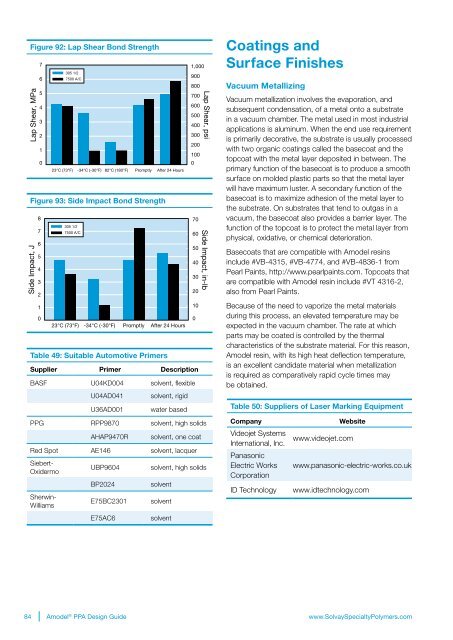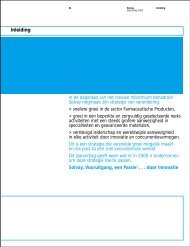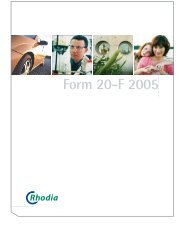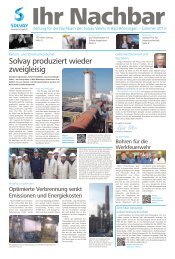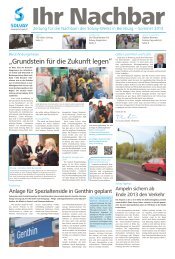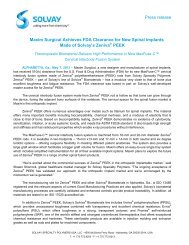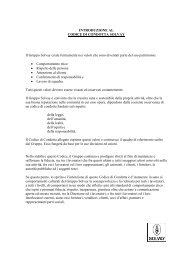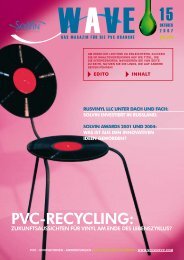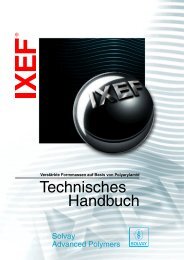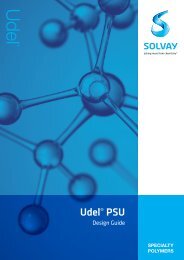Design Guide - Solvay Plastics
Design Guide - Solvay Plastics
Design Guide - Solvay Plastics
Create successful ePaper yourself
Turn your PDF publications into a flip-book with our unique Google optimized e-Paper software.
Figure 92: Lap Shear Bond Strength<br />
Lap Shear, MPa<br />
7<br />
6<br />
5<br />
4<br />
3<br />
2<br />
1<br />
0<br />
305 1/2<br />
7500 A/C<br />
23°C (73°F) -34°C (-30°F) 82°C (180°F) Promptly After 24 Hours<br />
Figure 93: Side Impact Bond Strength<br />
Side Impact, J<br />
8<br />
7<br />
6<br />
5<br />
4<br />
3<br />
2<br />
1<br />
0<br />
305 1/2<br />
7500 A/C<br />
23°C (73°F) -34°C (-30°F) Promptly After 24 Hours<br />
1,000<br />
900<br />
800<br />
700<br />
600<br />
500<br />
400<br />
300<br />
200<br />
100<br />
0<br />
Table 49: Suitable Automotive Primers<br />
Supplier Primer Description<br />
BASF U04KD004 solvent, flexible<br />
U04AD041 solvent, rigid<br />
U36AD001<br />
water based<br />
PPG RPP9870 solvent, high solids<br />
AHAP9470R<br />
70<br />
60<br />
50<br />
40<br />
30<br />
20<br />
10<br />
0<br />
solvent, one coat<br />
Red Spot AE146 solvent, lacquer<br />
Siebert-<br />
Oxidermo<br />
UBP9604 solvent, high solids<br />
Sherwin-<br />
Williams<br />
BP2024<br />
E75BC2301<br />
solvent<br />
solvent<br />
Lap Shear, psi<br />
Side Impact, in-lb<br />
Coatings and<br />
Surface Finishes<br />
Vacuum Metallizing<br />
Vacuum metallization involves the evaporation, and<br />
subsequent condensation, of a metal onto a substrate<br />
in a vacuum chamber. The metal used in most industrial<br />
applications is aluminum. When the end use requirement<br />
is primarily decorative, the substrate is usually processed<br />
with two organic coatings called the basecoat and the<br />
topcoat with the metal layer deposited in between. The<br />
primary function of the basecoat is to produce a smooth<br />
surface on molded plastic parts so that the metal layer<br />
will have maximum luster. A secondary function of the<br />
basecoat is to maximize adhesion of the metal layer to<br />
the substrate. On substrates that tend to outgas in a<br />
vacuum, the basecoat also provides a barrier layer. The<br />
function of the topcoat is to protect the metal layer from<br />
physical, oxidative, or chemical deterioration.<br />
Basecoats that are compatible with Amodel resins<br />
include #VB-4315, #VB-4774, and #VB-4836-1 from<br />
Pearl Paints, http://www.pearlpaints.com. Topcoats that<br />
are compatible with Amodel resin include #VT 4316-2,<br />
also from Pearl Paints.<br />
Because of the need to vaporize the metal materials<br />
during this process, an elevated temperature may be<br />
expected in the vacuum chamber. The rate at which<br />
parts may be coated is controlled by the thermal<br />
characteristics of the substrate material. For this reason,<br />
Amodel resin, with its high heat deflection temperature,<br />
is an excellent candidate material when metallization<br />
is required as comparatively rapid cycle times may<br />
be obtained.<br />
Table 50: Suppliers of Laser Marking Equipment<br />
Company<br />
Videojet Systems<br />
International, Inc.<br />
Panasonic<br />
Electric Works<br />
Corporation<br />
ID Technology<br />
Website<br />
www.videojet.com<br />
www.panasonic-electric-works.co.uk<br />
www.idtechnology.com<br />
E75AC6<br />
solvent<br />
84 Amodel ® PPA <strong>Design</strong> <strong>Guide</strong><br />
www.<strong>Solvay</strong>SpecialtyPolymers.com


